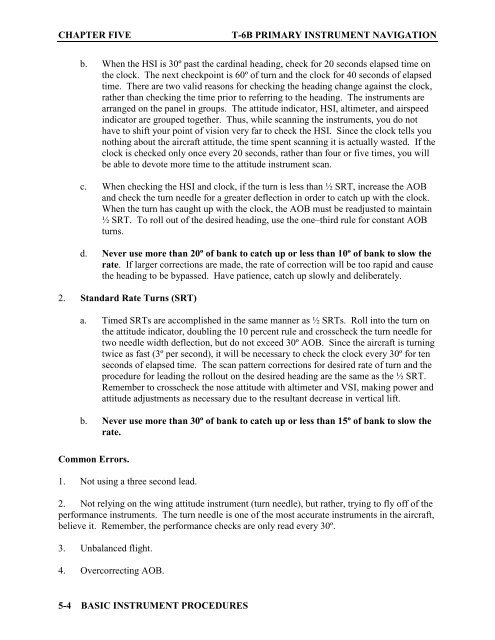Flight Training Instruction - Cnatra - U.S. Navy
Flight Training Instruction - Cnatra - U.S. Navy
Flight Training Instruction - Cnatra - U.S. Navy
Create successful ePaper yourself
Turn your PDF publications into a flip-book with our unique Google optimized e-Paper software.
CHAPTER FIVE T-6B PRIMARY INSTRUMENT NAVIGATION<br />
b. When the HSI is 30º past the cardinal heading, check for 20 seconds elapsed time on<br />
the clock. The next checkpoint is 60º of turn and the clock for 40 seconds of elapsed<br />
time. There are two valid reasons for checking the heading change against the clock,<br />
rather than checking the time prior to referring to the heading. The instruments are<br />
arranged on the panel in groups. The attitude indicator, HSI, altimeter, and airspeed<br />
indicator are grouped together. Thus, while scanning the instruments, you do not<br />
have to shift your point of vision very far to check the HSI. Since the clock tells you<br />
nothing about the aircraft attitude, the time spent scanning it is actually wasted. If the<br />
clock is checked only once every 20 seconds, rather than four or five times, you will<br />
be able to devote more time to the attitude instrument scan.<br />
c. When checking the HSI and clock, if the turn is less than ½ SRT, increase the AOB<br />
and check the turn needle for a greater deflection in order to catch up with the clock.<br />
When the turn has caught up with the clock, the AOB must be readjusted to maintain<br />
½ SRT. To roll out of the desired heading, use the one–third rule for constant AOB<br />
turns.<br />
d. Never use more than 20º of bank to catch up or less than 10º of bank to slow the<br />
rate. If larger corrections are made, the rate of correction will be too rapid and cause<br />
the heading to be bypassed. Have patience, catch up slowly and deliberately.<br />
2. Standard Rate Turns (SRT)<br />
a. Timed SRTs are accomplished in the same manner as ½ SRTs. Roll into the turn on<br />
the attitude indicator, doubling the 10 percent rule and crosscheck the turn needle for<br />
two needle width deflection, but do not exceed 30º AOB. Since the aircraft is turning<br />
twice as fast (3º per second), it will be necessary to check the clock every 30º for ten<br />
seconds of elapsed time. The scan pattern corrections for desired rate of turn and the<br />
procedure for leading the rollout on the desired heading are the same as the ½ SRT.<br />
Remember to crosscheck the nose attitude with altimeter and VSI, making power and<br />
attitude adjustments as necessary due to the resultant decrease in vertical lift.<br />
b. Never use more than 30º of bank to catch up or less than 15º of bank to slow the<br />
rate.<br />
Common Errors.<br />
1. Not using a three second lead.<br />
2. Not relying on the wing attitude instrument (turn needle), but rather, trying to fly off of the<br />
performance instruments. The turn needle is one of the most accurate instruments in the aircraft,<br />
believe it. Remember, the performance checks are only read every 30º.<br />
3. Unbalanced flight.<br />
4. Overcorrecting AOB.<br />
5-4 BASIC INSTRUMENT PROCEDURES
















